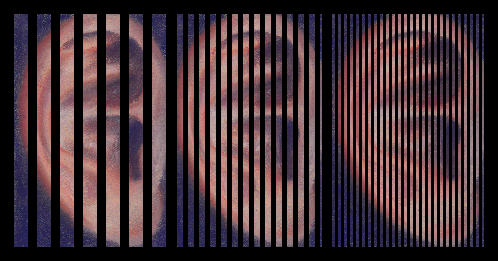Sounds of Silence

When I was a kid we had a small black & white television that never quite worked right. If you positioned the rabbit ears just so—and no one turned on the kitchen blender—the signal to snow ratio would be just barely high enough to make it through an episode of “The Cosby Show.” Humans are great at filling in missing visual information. Talis Bachmann, for example, demonstrated that people could accurately identify faces from a coarse grid of only 16 x 24 pixels, comparable to the left-most image of Einstein below.

The subjects filled in the missing music in familiar songs, hearing it in their mind’s ear.
So how well can people recognize degraded audio signals? I started thinking about that question when reading Musicophilia, fascinating “tales of music and the brain” by Oliver Sacks. In it Sacks relates the story of a friend who sits down to listen to his favorite Mozart record and proceeds to thoroughly enjoy the music, only later realizing that he had never actually turned on his record player. It seems likely that either Sacks or his friend is indulging in poetic hyperbole. Nevertheless, “musical imagery”—the subjective experience of hearing music absent auditory stimulation—occurs quite regularly in most people and is a well-documented physiological phenomenon. For example, Kraemer et al. presented people with familiar and unknown songs in which short sections were replaced by gaps of silence. Using functional MRI, they demonstrate that the silent gaps embedded in familiar songs induced greater activation in the auditory cortex than did the gaps in unknown songs. The subjects, in other words, filled in the missing music in familiar songs, hearing it in their mind’s ear.[1]
Now on to this week’s puzzle. Each of the mystery songs below was sectioned into super short segments—one-tenth of a second long—and 90% of these segments were replaced with silence. Consequently, for every second of play time, you hear one-tenth of a second of music. How good is your mind’s ear at reconstructing the songs? Bragging rights go to the first person to name all five songs correctly. Leave us a comment with your guesses. Good luck!
NB: Einstein was pixelated with Processing, and the audio clips were generated with SoX. Thanks to Walter Kim and Jake Hofman for pointing me to those cool tools.
Illustration by Kelly Savage
Addendum
Congratulations to puzzle winner Kevin Canini, who successfully identified all five mystery songs less than hour after they were posted! Honorable mention goes to Jeff Ely for identifying the super tough challenge song, which I actually thought no one was going to figure out. If you didn’t identify all the tunes and want to keep playing, here are progressively less degraded versions of the mystery songs above. The final sample in each sequence is the original, undistorted version.
1. 90% Degraded » 80% Degraded » 60% Degraded » Original Clip
2. 90% Degraded » 80% Degraded » 60% Degraded » Original Clip
3. 90% Degraded » 80% Degraded » 60% Degraded » Original Clip
4. 90% Degraded » 80% Degraded » 60% Degraded » Original Clip
5. 90% Degraded » 80% Degraded » 60% Degraded » Original Clip
Footnotes
[1] Sacks makes a much stronger—and ostensibly false—statement when describing Kraemer et al.’s work, claiming that “the silent gaps in familiar songs were not consciously noticed by their subjects.” While participants may have heard the missing music in their mind’s ear, they almost certainly knew it was imagined. To wit, the gaps in even very mildly degraded versions of the mystery songs are quite jarring.
